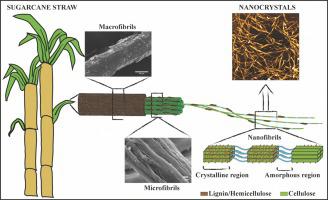Industrial Crops and Products ( IF 5.6 ) Pub Date : 2020-09-18 , DOI: 10.1016/j.indcrop.2020.112938 Stanley Bilatto , Jose M. Marconcini , Luiz H.C. Mattoso , Cristiane S. Farinas

|
Efficient use of the entire lignocellulosic biomass is important for biorefinery sustainability, especially considering the extraction of high value-added products, such as nanocellulosic materials. This work investigates the feasibility of using sugarcane straw as a feedstock to obtain lignocellulose nanocrystals (LCNCs). Together with bagasse, the straw is a residue from the processing of sugarcane in the ethanol/sugar mills, but its effective use remains to be further studied. An organosolv pretreatment process was first applied to the straw for partial removal of the lignin and hemicellulose contents (reductions of 72.2 and 62.1 %, respectively) and to increase the surface area (observed by scanning electron microscopy and atomic force microscopy). Acid hydrolysis carried out for different reaction times, with or without mechanical treatment, resulted in high yields of sugarcane straw LCNCs (40–64 % of the total mass). X-ray diffraction analyses showed that the crystallinity of the LCNCs increased from 65 to 80 %, with an estimated average elementary crystallite size of 3.3 nm. The aspect ratios of the LCNCs were determined by AFM and ranged from 18.0–30.1. The onset of thermal degradation of the LCNCs occurred between 145 and 191 °C. The findings demonstrated the effective extraction of cellulose nanocrystals with residual lignin from sugarcane straw, opening the possibility of obtaining high value-added nanomaterials and contributing to the sustainability of future lignocellulosic biomass biorefineries.
中文翻译:

甘蔗秸秆的木质纤维素纳米晶体
有效利用整个木质纤维素生物质对于生物精炼厂的可持续性非常重要,尤其是考虑到高附加值产品(例如纳米纤维素材料)的提取。这项工作调查了使用甘蔗秸秆作为原料获得木质纤维素纳米晶体(LCNC)的可行性。秸秆与甘蔗渣一起,是乙醇/糖厂中甘蔗加工过程中的残留物,但其有效用途仍有待进一步研究。首先将有机溶剂预处理工艺应用于秸秆,以部分除去木质素和半纤维素含量(分别减少72.2%和62.1%)并增加表面积(通过扫描电子显微镜和原子力显微镜观察)。在不同的反应时间进行酸水解,无论是否经过机械处理,导致甘蔗秸秆LCNC产量高(占总质量的40–64%)。X射线衍射分析表明,LCNC的结晶度从65%增至80%,估计的平均基本晶粒尺寸为3.3 nm。LCNC的长宽比由AFM确定,范围为18.0-10.3。LCNC的热降解发生在145至191°C之间。研究结果表明,可以从甘蔗秸秆中有效地利用残留的木质素提取纤维素纳米晶体,为获得高附加值的纳米材料提供了可能性,并为未来的木质纤维素生物质生物提炼厂的可持续性做出了贡献。估计的平均基本微晶尺寸为3.3 nm。LCNC的长宽比由AFM确定,范围为18.0-10.3。LCNC的热降解发生在145至191°C之间。研究结果表明,可以从甘蔗秸秆中有效地利用残留的木质素提取纤维素纳米晶体,为获得高附加值的纳米材料提供了可能性,并为未来的木质纤维素生物质生物提炼厂的可持续性做出了贡献。估计的平均基本微晶尺寸为3.3 nm。LCNC的长宽比由AFM确定,范围为18.0-10.3。LCNC的热降解发生在145至191°C之间。研究结果表明,可以从甘蔗秸秆中有效地利用残留的木质素提取纤维素纳米晶体,为获得高附加值的纳米材料提供了可能性,并为未来的木质纤维素生物质生物提炼厂的可持续性做出了贡献。











































 京公网安备 11010802027423号
京公网安备 11010802027423号